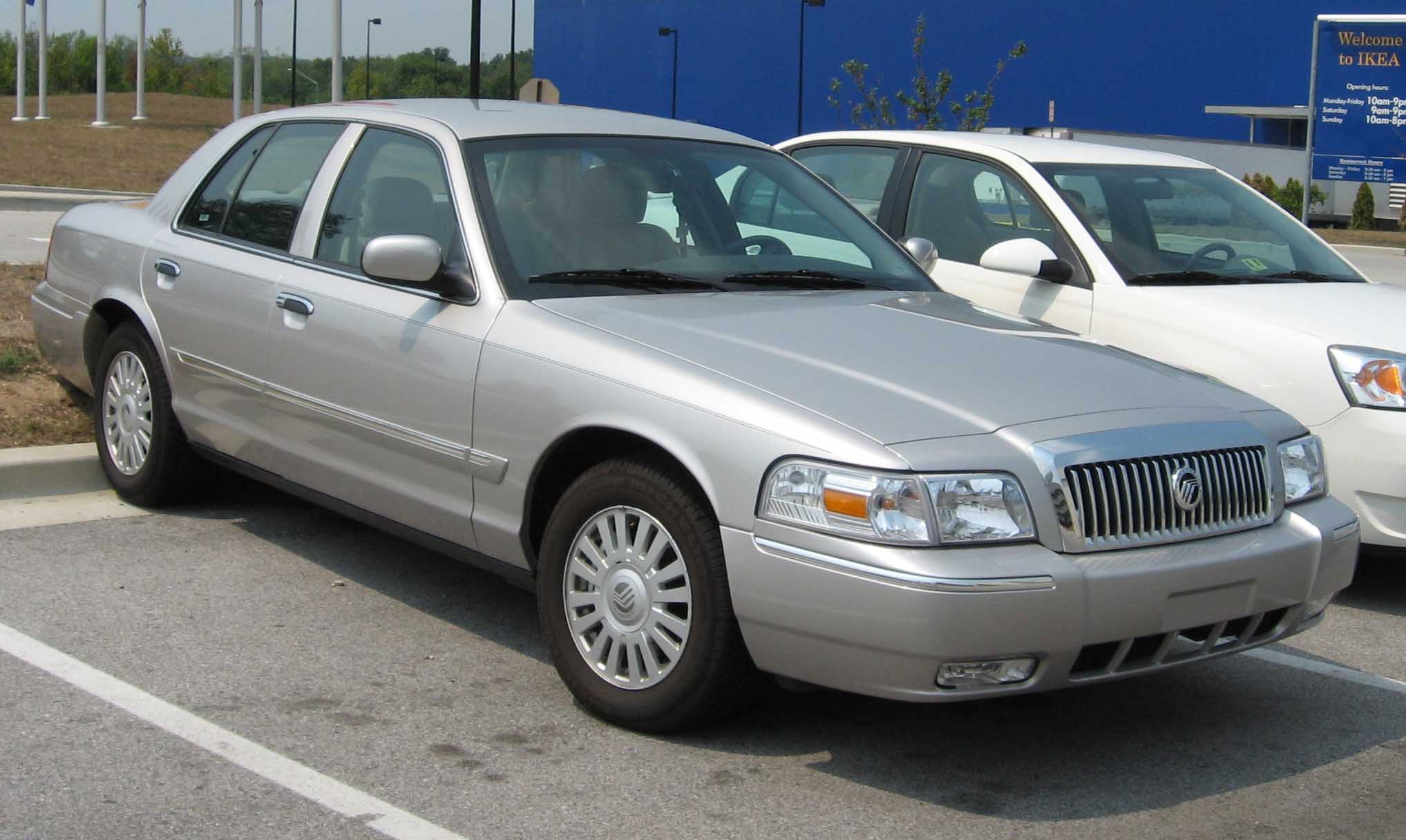The Twentieth-century ‘boilerplate American sedan’ was supported by five pillars. The first is a body-on-frame construction to keep repairs cheap, exteriors fresh, and curb weights high. The second pillar is a V8–not because its a performance car, but because it probably needs it. The third is a solid rear axle, because independent rear suspension is fragile, complicated, and definitely newfangled. The fourth is rear-wheel-drive, because front wheel drive isn’t right, and torque steer isn’t natural. The final pillar: an air conditioning system with enough BTUs to freeze over hell at one’s convenience.
By this definition, the final boilerplate American sedan was the second generation Ford Crown Victoria. Production started in 1997, ended in 2011, and they sold 1.5 million of them.
The Basics

The “Crown Vic’ was actually five cars with varying differences. Ford made both the regular Crown Vic and the Police Interceptor (known commonly as the P71). Mercury made the higher-class Grand Marquis, and the higher-performance Marauder. Lincoln made the most luxurious version–the upper-crust Town Car.
These cars had a lot in common, which is where I’ll start.
They all had the 4.6 liter Modular engine, but in varying states of tune. It made between 200 and 300 horsepower, had single overhead cams (two valves per cylinder on most cars), and was kept naturally aspirated in the Panther platform family.
They all had the same basic suspension layout, with shock and spring rates all being similar. Interestingly, the rear suspension was quite sophisticated despite being a solid rear axle, having two longitudinal lower links, two triangulated upper links (until 1998 when they switched to longitudinal), and a Watt’s Linkage in place of the typical Panhard Rod (after 1998), which is very uncommon.
The Watt’s Linkage

This animation of the Watt’s linkage illustrates why it had an advantage over the Panhard rod. The red dot portion is where it would be mounted to the differential. It controls the ‘side-to-side’ movement of the rear end without jerking the entire axle one way or the other like a Panhard rod does. I had a very niche obsession with the Watt’s linkage for some time. Just a little personal info there. In 2003, the Panther platform got suspension revisions and a change from recirculating ball steering (typically seen on trucks) to rack and pinion.
They all had four-speed automatic transmissions, but the P71s had stronger units intended to weather more abuse. Later cars would all get the heavier duty transmission.
They also all looked rather similar, but each offered their own colors, features, and quantities of chrome. All of them were offered in a long wheelbase configuration (besides the P71). I’m not going to dig up every microscopic detail of each model, as we must leave something for forum members to argue about. I will only cover relevant and reasonably interesting information.
The Ford Crown Victoria
The Crown Victoria was the most basic Panther platform car you could get. Starting at $23,705 in 2003 (about $33k today), it was the cheapest of the lot.
The base car had between 200 and 224 horsepower, depending on how new it was. You could boost this number could by approximately 15 if you opted for a dual exhaust, meaning the most powerful Crown Victoria available had 239 horsepower. At a curb weight of just a hair over four thousand pounds, this car isn’t very fast. Sixty is met somewhere around eight seconds, (sometimes closer to nine), and the quarter mile typically takes around… Here wait a minute… It’s still coming… Sixteen seconds. However, I’m guessing not a lot of people originally bought these cars for the performance, they bought them for the myriad of options on the inside.
Option City, U.S.A.
There’s so many different options for this car, and so many different trims across the various different cars on the Panther platform, that it’s hard to keep track of all of them. Not only is it hard to keep track, but most are all really boring, and offer no mechanical changes. Here’s a few interesting ones:
The LX Sport trim / Handling & Performance package replaced the rear coil springs with air springs, and added a swaybar (the stock Crown Victorias did not have one standard.) The rear axle ratio was also increased from 2.73:1 to 3.27:1.
Also offered with this car (for some reason) was five passenger seating. I would say it’s basically a front bench seat like that found in the Chevy Impala from the same era, however the center front seat in the Crown Victoria seems to exist primarily as a very thick armrest. It can be folded up into a seat when an unfortunate victim is found.

You can sort of see what that looks like in this picture from a Grand Marquis (where five-passenger seating was also offered.)
The car’s sale to the public ended in 2007, but it continued to be sold to fleets until 2011. Many were sold as fleet cars, primarily as taxis.
I remember one time in London during a heatwave me and my brother hailed a cab, stepping inside to realize the standard London Black cab had no A/C, and a four-cylinder diesel engine. This was uncivilized. I told the very friendly and professional cab driver (they train the hell out of them over in the UK) that many American cabs had V8s, couches for rear seats, and positively arctic air conditioning. I’m not certain if he believed me.
The Police Interceptor (P71)

The police interceptor is the toughest, hardest working, and one of the most common Crown Victorias out there. You can get them for dirt at police auctions (if you’re into that kind of thing) and they generally spent most of their lives idling.
Drivetrain differences included a new intake and standard dual exhaust (that did not have any resonators) which boosted horsepower to 250. All P71s have a slightly higher idle than usual, and many of them have larger batteries and alternators. The engine also got an external oil cooler, and the aforementioned beefier transmission had more aggressive shift points. At the back was a 3.27:1 open rear differential. Both 3.27:1 and 3.55:1 locking units were also an option.
The chassis had extensive work done to make it more suitable for… Uh… Intercepting.
The shocks were stiffer and stronger, as were the springs. The new springs raised the car by nearly an inch. The rear anti roll bar (the cop car has one!) is thinner than on other Crown Victorias, and the car had steel wheels with a chrome hubcap. The chassis itself was beefed up, the brakes got different pads & re-calibrated ABS, and I’ve also heard the car had stronger / extra skidplates, but I can’t confirm this anywhere.
So you should get one?
Due to these various upgrades, cop cars at first glance are desirable. At second glance, it’s a cop car, and they are not. They’re risky to buy because cop cars either had the shit beat out of them, or sat around idling forever.
I don’t recommend buying one, but on the other hand, cop shows nowadays just aren’t the same without the classic sound of some state trooper flooring his P71. That’s one noise you cant make in an explorer.
The Lincoln Town Car

The Lincoln Town Car was the nicest Panther platform car money could buy. The standard Crown Victoria might have given you the impression that it had all of the makings of a luxury car, but it really wasn’t one. There may be some truth to that, however there is no truth in saying that Town Car is not. The Town Car was, is, and forever will be some kind of status symbol.
The Mercury and Crown Victoria were about the same price new. This was not so for the Town Car. The base model Town Car costed $40,785. The most expensive Town car you could buy, The Long wheelbase, top trim “Cartier” (excluding special editions) was $51,315. In today’s money, that’s right around seventy-one thousand dollars.
There were many more standard luxury features in the Town Car. Leather was standard, there was more chrome, the quality control was better, and it was just nicer than any other Crown Victoria. The top trim Cartier came with just about everything standard, including three-zone climate control and heated seats for the rear passengers.
Mechanical Changes
Under the hood there was no additional power, but that would’ve been… What’s the word I’m looking for here… If this was an English website, I would use the word “Ghastly”.
Staying on the topic of mechanical changes, The rear suspension was also devoid of coil springs, with airbags being the only option. This car apparently got worse fuel economy than other Crown Victorias because of the added weight of all of the equipment.
I have been in the back seat of one of these cars before. People always exaggerate to say a car’s seats are like a couch. The back seat of the Lincoln Town Car is not like a couch, it is a couch. The leather is all fantastic, and it cradles like you have yet to leave the womb. It’s comfortable, private, you are just completely at ease.
An excellent piece of writing was done by Misha Lanin concerning the Town Car in Jalopnik, and I do recommend you at least skim through it.
The Mercury Grand Marquis

The Grand Marquis was available with more options than the Crown Victoria, but was basically the same car at base price. The standard Grand Marquis was just a Crown Victoria with different badging, a little more chrome, and a nicer grille. The base price was nearly the same at $23,970 (265 dollars more). This is the least interesting Panther platform car that Mercury made. Yes, they made two.
The Mercury Marauder

The Marauder is the mountaintop. Feast your eyes upon the sharpest, meanest, most powerful Panther platform vehicle ever.
The Marauder is sort of like Mercury’s last stand. By the time Mercury was on the verge of getting canned, their lineup was pretty piss-poor. Nobody was going to buy them a Mercury and cruise it up and down the road. Their cars were all pretty much just hastily done re-badges of regular Ford products. Maybe with a different grille or headlights.
What really sucks about situations like that are the designers and engineers don’t like it either. They didn’t go to school or get into the automotive field to do 600 iterations of a new grille for the Mercury Mariner. You can tell that the Marauder was a last ditch attempt to make something they would actually wanna buy.
Stealing parts from cops
The Marauder has a lot of parts from the P71. The 3.55:1 locking rear differential, the brakes, many of the chassis upgrades, and the driveshaft. It’s on lowered springs, has a new exhaust, and most importantly: a different engine. Under the hood, It’s still a 4.6 liter Mod motor. However it’s the four-valve, DOHC variant. This boosts output to a hair over 300 horsepower.
Unlike nearly every other Panther platform car, the Marauder also got… a tachometer! What a thought.
Its very easy to spot Marauders, as most of them came murdered out from the factory. The Marauder gets its own grille, slightly smoked taillights, different headlights, and new front & rear fascias. It also had big 18″ wheels, at the center of which was the face of the Roman god Mercury (this was the brand’s original logo). Who would’ve thought a little Greco-Romanism would slip into a Ford product in 2004.
All in all, they sold 11,052 in two years, the vast majority being black (three other colors were also available). They are very desirable today, and the prices reflect that. If I could have any Panther car to drive, it would be this one. The Town Car would my first choice to be driven around in. The P71 would be my last choice in this regard.


Leave a Reply